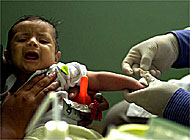Grip of AIDS tightens

Twenty years ago, health officials in the United States published the first official report of the disease now known as AIDS. Since then, the epidemic has claimed 22 million lives worldwide and over 36 million people are living with HIV, the virus which causes AIDS.
There is still no cure and no vaccine but the struggle to control the epidemic has yielded a growing arsenal of drugs and helped spur major leaps in our understanding of the immune system and viruses.
On Tuesday, scientists in Geneva announced the discovery of a molecule which might one day mark a turning point in our efforts to combat the disease.
“It’s a very active molecule – a million times more active than any other anti-HIV compound – so it means that it is extremely selective, it can find its target in a very precise way,” said Professor Jean Tronchet of Geneva University.
AIDS is caused by the human immunodeficiency virus – HIV. By killing or damaging cells of the body’s immune system, HIV progressively destroys the body’s ability to fight infections and certain cancers and leaves the body vulnerable to diseases which would not normally be life threatening.
Scientists trying to develop a cure for AIDS have been pursuing several lines of inquiry. Medicines need to be developed to kill HIV but not the cells that the viruses live in.
“The fact that this molecule is so active has important consequences,” said Tronchet. “First, you don’t need to use as much of the compound so it can be much cheaper.
“Secondly and more importantly, because the molecule is very active it is highly specific so it is less likely to harm other organs.”
It could be many years – if ever – before it is known whether this compound will really be effective in the fight against HIV/AIDS.
A French pharmaceuticals firm, Mayoli Spindler, is set to conduct pre-clinical trials, which will last about a year. Depending on the outcome, some three to four years of rigorous clinical testing will follow.
by Vincent Landon

In compliance with the JTI standards
More: SWI swissinfo.ch certified by the Journalism Trust Initiative
You can find an overview of ongoing debates with our journalists here . Please join us!
If you want to start a conversation about a topic raised in this article or want to report factual errors, email us at english@swissinfo.ch.